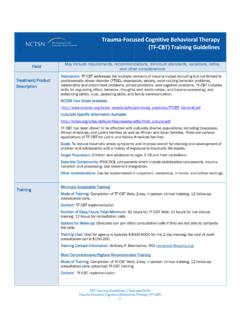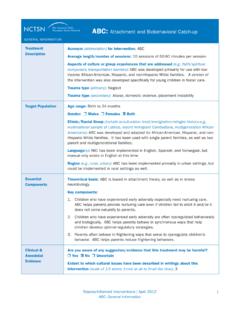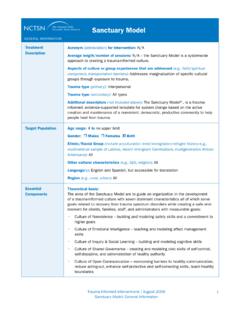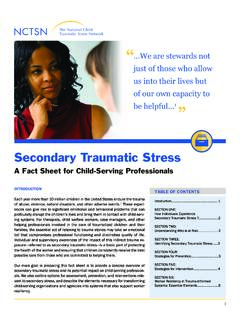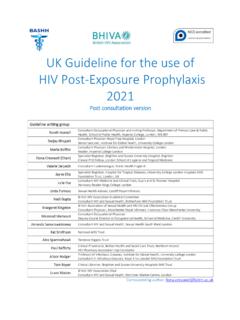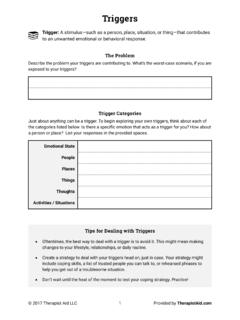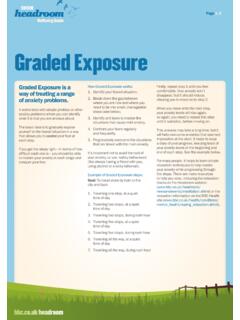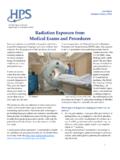Transcription of TF-CBT: NAME
1 TF-CBT: NAME: Trauma-Focused Cognitive Name Spelled Out Behavioral therapy GENERAL INFORMATION. Treatment Acronym (abbreviation) for intervention: TF-CBT. Description Average length/number of sessions: 12-25 sessions (60-90 minute sessions, divided approximately equally between youth and parent/caregiver). Aspects of culture or group experiences that are addressed ( , faith/spiritual component, transportation barriers): TF-CBT has been modified to address the needs of Latino, Native American, deaf and hearing impaired, military and many international populations. It has been provided in group formats and in multiple settings( , homes, foster homes, schools, residential treatment facilities) to address transportation barriers Trauma type (primary): Sexual abuse, domestic violence, traumatic grief, disaster, terrorism, multiple or complex traumas Trauma type (secondary): Other trauma types Additional descriptors (not included above): TF-CBT addresses the multiple domains of trauma impact including but not limited to Posttraumatic Stress Disorder (PTSD), depression, anxiety, externalizing behavior problems, relationship and attachment problems, school problems and cognitive problems.
2 TF-CBT includes skills for regulating affect, behavior, thoughts and relationships, trauma processing, and enhancing safety, trust, parenting skills and family communication. Target Population Age range: 3 to 21. x Both Gender: r Males r Females r Ethnic/Racial Group (include acculturation level/immigration/refugee , multinational sample of Latinos, recent immigrant Cambodians, multigeneration African Americans): TF-CBT has been tested in Caucasian, African American and Latino populations as well as in European, Australian and African youth with positive out- comes in multiple domains. Applications for childhood traumatic grief (CTG) have also been used for multiple populations with positive outcomes. Other cultural characteristics ( , SES, religion): TF-CBT has been used with families of diverse SES and religions.
3 Language(s): The TF-CBT treatment book has been translated into Chinese (Mandarin), German, Dutch, Polish, Japanese and Korean. French and Russian translations are underway. Instruments to assess TF-CBT outcomes are available in multiple languages including all of the above as well as Spanish and a variety of African tribal languages. Region ( , rural, urban): TF-CBT has been used in urban, suburban and rural regions. Other characteristics (not included above): TF-CBT has been modified for use in military settings as well as for residential treatment facilities ( , additional training materials are available for training direct care staff to support the use of TF-CBT skills in the residential setting); in schools; and for youth with developmental challenges.
4 Trauma-Informed Interventions | April 2012 1. TF-CBT: General Information TF-CBT: NAME: Trauma-Focused Cognitive Name Spelled Out Behavioral therapy GENERAL INFORMATION. Target Population TF-CBT should be provided to youth who have significant emotional or behavioral continued difficulties related to one or more traumatic life events (including complex trauma);. youth do not have to meet PTSD criteria to receive TF-CBT. TF-CBT treatment has been shown to result in improvement in PTSD symptoms, depression, anxiety symptoms, externalizing behavioral problems, sexualized behavior problems, shame, trauma- related cognitions, interpersonal trust, and social competence. Essential Theoretical basis: Cognitive-behavioral, family, empowerment Components Key components: Establishing a therapeutic relationship with youth and parent Use of gradual exposure throughout treatment PRACTICE components: Psychoeducation about child trauma and trauma reminders Parenting component including parenting skills Relaxation skills individualized to youth and parent Affective modulation skills tailored to youth, family and culture Cognitive coping.
5 Connecting thoughts, feelings and behaviors Trauma narrative and processing In vivo mastery of trauma reminders Conjoint youth-parent sessions Enhancing safety and future developmental trajectory Traumatic grief components Clinical & Are you aware of any suggestion/evidence that this treatment may be harmful? Anecdotal r Yes rx No r Uncertain Evidence Extent to which cultural issues have been described in writings about this intervention (scale of 1-5 where 1=not at all to 5=all the time). 3. This intervention is being used on the basis of anecdotes and personal communications only (no writings) that suggest its value with this group. r Yes r x No Are there any anecdotes describing satisfaction with treatment, drop-out rates x Yes r No ( , quarterly/annual reports)?
6 R If YES, please include citation: All of our treatment outcome studies (cited below) include dropout statistics. x Yes r No Has this intervention been presented at scientific meetings? r 2 The National Child Traumatic Stress Network TF-CBT: NAME: Trauma-Focused Cognitive Name Spelled Out Behavioral therapy GENERAL INFORMATION. Clinical & If YES, please include citation(s) from last five presentations: Anecdotal Numerous citations available upon request. Evidence continued Are there any general writings which describe the components of the intervention or how to administer it? rx Yes r No If YES, please include citation: Cohen, JA, Mannarino, AP & Deblinger, E (2006). Treating trauma and traumatic grief in children and adolescents. New York: Guilford Press Free online training course: TF-CBT Web: x Yes r No Has the intervention been replicated anywhere?
7 R Other countries? (please list). Zambia; Cambodia; Norway; Germany; Holland; Japan Other clinical and/or anecdotal evidence (not included above): Multiple replication studies Research Evidence Sample Size (N) and Breakdown Citation (by gender, ethnicity, other cultural factors). TF-CBT has the strongest research evidence of any treatment model for traumatized children. Multiple randomized controlled trials (RCT). and replication studies including international studies have been conducted documenting the effectiveness of TF-CBT for improving a range of problems for these children. Pilot Trials/Feasibility N=19 Deblinger et al, 1990. Trials (w/o control groups) Gender: female=19, male=0. Clinical Trials Foster care: TF-CBT=69, Usual care Weiner et al, 2009.
8 (w/control groups). N=2218 CATS Consortium, 2010. Disaster: N=306. Trauma-Informed Interventions | April 2012 3. TF-CBT: General Information TF-CBT: NAME: Trauma-Focused Cognitive Name Spelled Out Behavioral therapy GENERAL INFORMATION. Research Evidence Sample Size (N) and Breakdown Citation (by gender, ethnicity, other cultural factors). Randomized Controlled 921 total youth; 743 treatment Cohen & Mannarino, 1996. Trials completers Cohen, Mannarino & Knudsen, 2005. By gender: 507 female; 236 male Cohen, et al, 2004. By self-identified ethnicity: Cohen, et al, 2011. 447 Caucasian 176 African American Deblinger, et al, 1996. 29 Latino Deblinger et al, 2001. 42 Biracial 13 Other Deblinger et al, 2011. 36 Australian children King et al, 2000. Democratic Republic of Congo: O'Callaghan & McMullen,2012.
9 Former child soldiers: N=52. McMullen & O'Callaghan, 2012. Sex trafficked girls: N=52. Studies Describing Childhood traumatic grief: 61 Cohen, Mannarino & Knudsen, 2004. Modifications By gender: Cohen, Mannarino & Staron, 2006. 38 female, 23 male By ethnicity: 43 Caucasian 15 African American 3 Biracial Outcomes What assessments or measures are used as part of the intervention or for research purposes, if any? PTSD: UCLA PTSD Reaction Index; CPSS and/or KSADS. Depression: Children's Depression Index; TSCC. Anxiety: SCARED; STAIC; TSCC. Externalizing and Internalizing behavior problems: CBCL. Sexual behavior problems: CSBI or TSCC. Trauma-related cognitions: Children's Attribution and Perception Scale (CAPS). Parental support: PSQ. Parental distress: PERQ.
10 Parental depression: BDI. Parenting practices: Parenting Practices Questionnaire Parental conflict/violence: Conflict Tactics Questionnaire 4 The National Child Traumatic Stress Network TF-CBT: NAME: Trauma-Focused Cognitive Name Spelled Out Behavioral therapy GENERAL INFORMATION. Outcomes If research studies have been conducted, what were the outcomes? continued TF-CBT superior to Child Centered therapy , wait list and usual treatment on multiple outcomes listed above Implementation Space, materials or equipment requirements? Requirements & Private office or other meeting room for therapy sessions Readiness Supervision requirements ( , review of taped sessions)? Approved TF-CBT training and expert consultation (web-based; 2 days of face to face training; at least 6 months of twice monthly consultation with expert trainer) OR.

